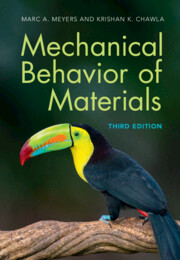Refine search
Actions for selected content:
106109 results in Materials Science
Advances in Material Science and Applications
- Bulk (Silicon) vs Nano (Graphene)
- Coming soon
-
- Expected online publication date:
- March 2026
- Print publication:
- 01 May 2027
-
- Book
- Export citation
Advances in Material Science and Applications
- Bulk (Silicon) vs Nano (Graphene)
- Coming soon
-
- Expected online publication date:
- February 2026
- Print publication:
- 01 May 2027
-
- Book
- Export citation
Tetragonal–cubic phase transition in RbGaSi2O6 synthetic leucite analogue
-
- Journal:
- Powder Diffraction , First View
- Published online by Cambridge University Press:
- 05 December 2025, pp. 1-10
-
- Article
-
- You have access
- Open access
- HTML
- Export citation
The crystal structures of methoxmetamine hydrochloride and methoxetamine hydrochloride determined from laboratory X-ray powder diffraction data contained in the Powder Diffraction File™
-
- Journal:
- Powder Diffraction , First View
- Published online by Cambridge University Press:
- 01 December 2025, pp. 1-12
-
- Article
-
- You have access
- Open access
- HTML
- Export citation
X-ray diffraction pattern analysis of CrFeCoNi high-entropy alloy deposited via cold spray
-
- Journal:
- Powder Diffraction , First View
- Published online by Cambridge University Press:
- 28 November 2025, pp. 1-10
-
- Article
- Export citation
Crystal structure of resmetirom heminonahydrate Form CSI, C17H12Cl2N6O4(H2O)4
-
- Journal:
- Powder Diffraction , First View
- Published online by Cambridge University Press:
- 28 November 2025, pp. 1-9
-
- Article
-
- You have access
- Open access
- HTML
- Export citation
Crystal structure of fluvoxamine maleate, (C15H22F3N2O2)(HC4H2O4)
-
- Journal:
- Powder Diffraction , First View
- Published online by Cambridge University Press:
- 27 November 2025, pp. 1-8
-
- Article
-
- You have access
- Open access
- HTML
- Export citation
Proposed crystal structure of dequalinium chloride Form A, C30H40N4Cl2
-
- Journal:
- Powder Diffraction , First View
- Published online by Cambridge University Press:
- 21 November 2025, pp. 1-7
-
- Article
-
- You have access
- Open access
- HTML
- Export citation
Proposed crystal structure of protriptyline hydrochloride Form A, C19H22NCl
-
- Journal:
- Powder Diffraction , First View
- Published online by Cambridge University Press:
- 21 November 2025, pp. 1-7
-
- Article
-
- You have access
- Open access
- HTML
- Export citation
Crystal structure of racemic afoxolaner, C26H17ClF9N3O3
-
- Journal:
- Powder Diffraction , First View
- Published online by Cambridge University Press:
- 18 November 2025, pp. 1-7
-
- Article
-
- You have access
- Open access
- HTML
- Export citation
74th Annual Denver X-ray Conference Report
-
- Journal:
- Powder Diffraction , First View
- Published online by Cambridge University Press:
- 18 November 2025, pp. 1-5
-
- Article
- Export citation
Calendar of Forthcoming Meetings
-
- Journal:
- Powder Diffraction / Volume 40 / Issue 3 / September 2025
- Published online by Cambridge University Press:
- 13 November 2025, pp. 253-254
-
- Article
-
- You have access
- HTML
- Export citation
The “chymistry” of Isaac Newton: a new Cu-acetate compound formed via crystallization
-
- Journal:
- Powder Diffraction / Volume 40 / Issue 3 / September 2025
- Published online by Cambridge University Press:
- 13 November 2025, pp. 183-189
-
- Article
-
- You have access
- Open access
- HTML
- Export citation
PDJ volume 40 issue 3 Cover and Front matter
-
- Journal:
- Powder Diffraction / Volume 40 / Issue 3 / September 2025
- Published online by Cambridge University Press:
- 13 November 2025, pp. f1-f4
-
- Article
-
- You have access
- Export citation
Calendar of Short Courses and Workshops
-
- Journal:
- Powder Diffraction / Volume 40 / Issue 3 / September 2025
- Published online by Cambridge University Press:
- 13 November 2025, p. 255
-
- Article
-
- You have access
- HTML
- Export citation
PDJ volume 40 issue 3 Cover and Back matter
-
- Journal:
- Powder Diffraction / Volume 40 / Issue 3 / September 2025
- Published online by Cambridge University Press:
- 13 November 2025, pp. b1-b2
-
- Article
-
- You have access
- Export citation
Exploring the tetragonal crystal structure of perovskites BaLa2Cu1−xBaxTi2O9 (x = 0.00, 0.15, 0.30) via X-ray diffraction and the Rietveld method
-
- Journal:
- Powder Diffraction , First View
- Published online by Cambridge University Press:
- 05 November 2025, pp. 1-7
-
- Article
-
- You have access
- Open access
- HTML
- Export citation
A Necessary and Sufficient Condition for the Unique Solution of the Bellman Equation for LTL Surrogate Rewards
-
- Journal:
- Research Directions: Cyber-Physical Systems / Accepted manuscript
- Published online by Cambridge University Press:
- 04 November 2025, pp. 1-13
-
- Article
-
- You have access
- Open access
- Export citation

Mechanical Behavior of Materials
-
- Published online:
- 31 October 2025
- Print publication:
- 22 May 2025
-
- Textbook
- Export citation
Repairing neural network-based control policies with safety preservation
-
- Journal:
- Research Directions: Cyber-Physical Systems / Volume 3 / 2025
- Published online by Cambridge University Press:
- 07 October 2025, e5
-
- Article
-
- You have access
- Open access
- HTML
- Export citation
